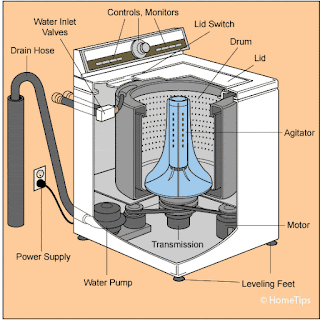MECHANISM DESCRIPTION
WASHING MACHINE
A washing machine is a home equipment that cleans and washes clothes, sheets, towels, and other fabric-based goods. It automates the washing process, making it more convenient and efficient than hand washing. A washing machine typically consists of a drum or tub in which the clothes are placed, as well as an agitator or impeller that pushes the garments around to ensure thorough cleaning. The machine is hooked up to a water supply, and water and detergent are added to the drum to make a cleaning solution. To agitate the garments and remove dirt, stains, and odors, the drum rotates or oscillates.
Drum
The drum is the central part of the washing machine where clothes are loaded for washing. It is typically perforated or equipped with paddles to facilitate water circulation and movement of clothes during the washing process.
Agitator
In some top-loading washing machines, an agitator or pulsator is present in the center of the drum. It rotates or moves back and forth to create a turbulent water flow, helping to agitate the clothes and remove dirt.
Motor
The motor is responsible for providing the necessary mechanical power to drive various functions of the washing machine, such as spinning the drum, rotating the agitator/pulsator, and operating the water pump. It is usually an electric motor controlled by the machine's electronic system.
Transmission
The transmission or gearbox serves to transfer power from the motor to different mechanical components of the washing machine. It may consist of gears, belts, or pulleys to achieve the desired speed and torque for different operations.
Water Pump
The water pump is responsible for draining water from the machine's drum. It is usually an electric pump that expels water through a drain hose connected to a plumbing system or a designated drain.
Lid
In top-loading washing machines, a lid is present to cover the drum during operation. It typically incorporates a safety lock mechanism that prevents the lid from opening while the machine is in use, ensuring user safety.
Lid Switch
The lid switch is a safety feature found in most washing machines. It is a small mechanism that detects whether the lid of the washing machine is closed or open. When the lid is closed, the switch is activated, allowing the machine to operate. If the lid is opened during a wash cycle, the lid switch will trigger and pause or stop the machine to prevent any accidents or injuries.
Leveling feet
Washing machines are equipped with adjustable leveling feet to ensure stability and balance. These feet are usually located at the bottom corners of the machine. By adjusting the height of the leveling feet, you can level the washing machine on uneven surfaces. This is important to prevent excessive vibrations, noise, and potential damage to the machine during operation.
Drain Hose
The drain hose is responsible for removing water from the washing machine during the drainage cycle. It is usually located at the back of the machine and is connected to a drain pipe or a utility sink. The drain hose allows the water to flow out of the machine and directs it to the appropriate drainage system. It is crucial to ensure that the drain hose is properly installed and free from any blockages to prevent water backup or leaks.
Water Inlet Valve
The water inlet valve controls the flow of water into the washing machine. It is connected to the water supply and operated by the machine's control system to regulate the amount of water required for each wash cycle.
Timer/Control System
The timer or control system in a washing machine allows users to select various wash cycles, set the washing duration, and control other functions. It coordinates the operation of different components, such as the motor, water inlet valve, and water pump, to execute the chosen wash program.


Comments
Post a Comment